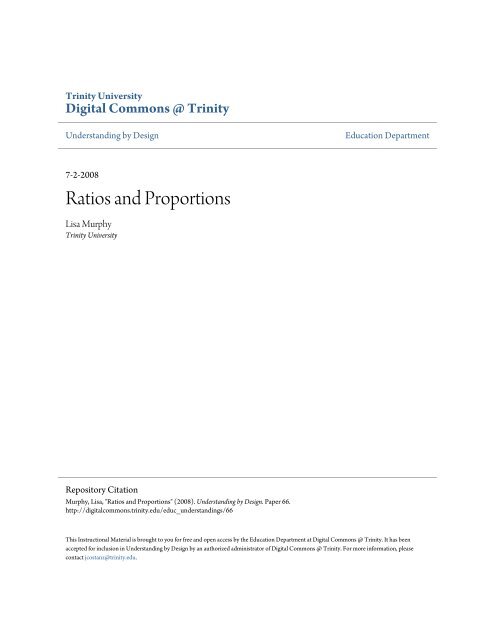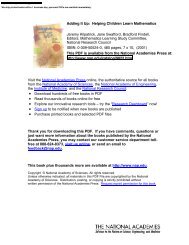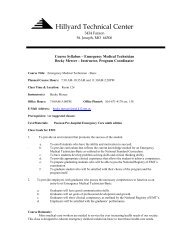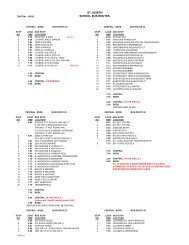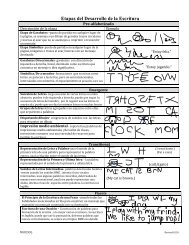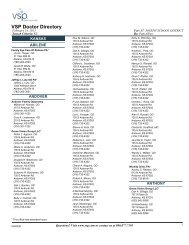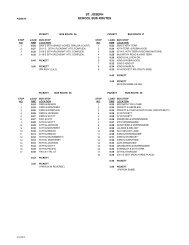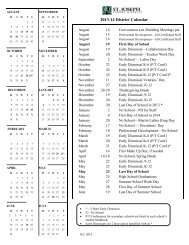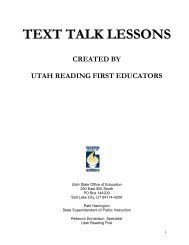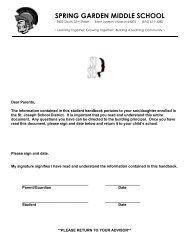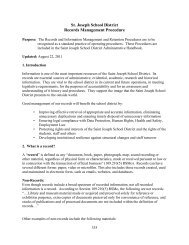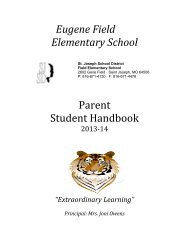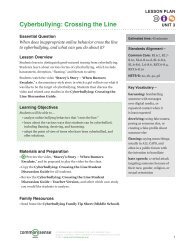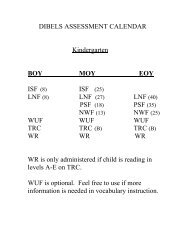Ratios and Proportions
Ratios and Proportions
Ratios and Proportions
You also want an ePaper? Increase the reach of your titles
YUMPU automatically turns print PDFs into web optimized ePapers that Google loves.
Trinity University<br />
Digital Commons @ Trinity<br />
Underst<strong>and</strong>ing by Design<br />
Education Department<br />
7-2-2008<br />
<strong>Ratios</strong> <strong>and</strong> <strong>Proportions</strong><br />
Lisa Murphy<br />
Trinity University<br />
Repository Citation<br />
Murphy, Lisa, "<strong>Ratios</strong> <strong>and</strong> <strong>Proportions</strong>" (2008). Underst<strong>and</strong>ing by Design. Paper 66.<br />
http://digitalcommons.trinity.edu/educ_underst<strong>and</strong>ings/66<br />
This Instructional Material is brought to you for free <strong>and</strong> open access by the Education Department at Digital Commons @ Trinity. It has been<br />
accepted for inclusion in Underst<strong>and</strong>ing by Design by an authorized administrator of Digital Commons @ Trinity. For more information, please<br />
contact jcostanz@trinity.edu.
UNDERSTANDING BY DESIGN<br />
Unit Cover Page<br />
Unit Title: <strong>Ratios</strong> <strong>and</strong> <strong>Proportions</strong><br />
Grade Level: 6 th<br />
Subject/Topic Area: Math<br />
Designed By: Lisa Murphy<br />
Time Frame: 4 weeks<br />
School District: North East Independent School District<br />
School: W.W. Jackson Middle School<br />
Brief Summary of Unit:<br />
In this unit students will be introduced to ratios <strong>and</strong> proportions. Students will have<br />
practice identifying ratios from pictures, graphs, models <strong>and</strong> word problems. Using these<br />
skills, students will then be able to identify proportional ratios <strong>and</strong> use ratios to describe<br />
proportional situations as well as to predict outcomes.<br />
To demonstrate their knowledge of ratios <strong>and</strong> proportional reasoning, students will<br />
complete a project assessment. The students will be given a recipe <strong>and</strong> then have to calculate<br />
the amounts of ingredients needed for various numbers of servings. The students will write<br />
down new versions of the recipes to be included in a class recipe book. To ensure that the<br />
recipes do have proportional amounts of ingredients, students may bring in a sample of their<br />
recipe to share with the class.
Unit: Ratio <strong>and</strong> Proportion<br />
Grade: 6 th<br />
Stage 1: Desired Results<br />
Underst<strong>and</strong>ings<br />
Students will underst<strong>and</strong> that…<br />
There is more than one way to solve a problem. (Overarching underst<strong>and</strong>ing for the year)<br />
<strong>Ratios</strong> can be used to describe proportional situations (<strong>Proportions</strong> are two ratios that are equal).<br />
<strong>Ratios</strong> <strong>and</strong> proportions can be represented in different ways (fraction, decimal, percent).<br />
Essential Questions<br />
Why are ratios <strong>and</strong> proportions important<br />
How are they used in the real world<br />
Does my answer make sense<br />
How can I compare two different things<br />
(How can we show the relationship between two<br />
quantities or values)<br />
How should I solve it<br />
(What number form should be used to solve a<br />
problem)<br />
Knowledge & Skill<br />
(NEISD scope & sequence; TEKS; Core; etc.)<br />
TEKS<br />
6.1b, 6.2c, 6.3a, 6.3b, 6.3c, 6.4a, 6.5a<br />
6.11a, 6.11b, 6.11c, 6.11d, 6.12a, 6.12b,<br />
6.13a, 6.13b<br />
Key Terms:<br />
Ratio, proportion, percent, equivalent<br />
Students will know:<br />
The relationship between ratios <strong>and</strong><br />
proportions.<br />
The different forms that are used to<br />
represent ratios.<br />
How ratios <strong>and</strong> proportions can be used in<br />
everyday situations (the real world).<br />
Students will be able to:<br />
Describe proportional situations with<br />
ratios.<br />
Make predictions using ratios.<br />
Represent proportions in various forms<br />
(models, fractions, decimals, percents).<br />
Solve problems using ratios <strong>and</strong><br />
proportions.
Stage 2: Assessment Evidence<br />
Performance Task:<br />
Rachel Ray needs your help! She is making desserts for two upcoming holiday parties <strong>and</strong> she is<br />
having a little trouble. All of the recipes she has make 12 servings. The organizers for one party<br />
have asked Rachel to bring 3 servings of several different recipes. The organizers of the second<br />
party are expecting a larger turn-out <strong>and</strong> have asked that Rachel bring 24 servings of each recipe.<br />
Rachel doesn’t know what to change so that she makes the right number of servings. She has<br />
asked you to help her figure out what changes need to be made to her recipe so that she can make<br />
3 servings <strong>and</strong> 24 servings of one of her dessert recipes. To thank you for your help, Rachel is<br />
going to take your new recipes <strong>and</strong> publish them in a new recipe book.<br />
Other evidence:<br />
(quizzes, tests, academic prompts, etc.<br />
note – these are usually included where appropriate in Stage 3 as well)<br />
Quiz<br />
Test<br />
Math Measures<br />
Daily Warm-Ups<br />
Agile Mind guided assessment<br />
Exemplar Problem – Raisin or Sneaker Problem<br />
Stage 3: Learning Activities<br />
(Steps taken to get students to answer Stage 1 questions <strong>and</strong> complete performance task)<br />
Day One<br />
Intro to Unit/Blue <strong>and</strong> Yellow Make Green<br />
To begin the unit on ratio <strong>and</strong> proportions, introduce the Essential Questions: Why are ratios <strong>and</strong><br />
proportions important How can I compare two different things How should I solve it<br />
The questions will be creatively written on poster size sheets of paper (For the first question the<br />
words ratio <strong>and</strong> proportion will be written in different yet proportional sizes, for the second<br />
question include various pictures of items to compare <strong>and</strong> for the third question write the possible<br />
forms that could be used to express an answer).<br />
Throughout the coming weeks we will be trying to answer these questions. The questions will be<br />
posted around the classroom where they can be easily seen by the students. They will be<br />
referenced throughout the unit.<br />
Students will be introduced to the concept of ratio <strong>and</strong> proportions by observing a Water Dye<br />
Coloring activity. Colored dye will be added to two beakers of water in different ratios.<br />
Students will record what happens to the color of the water. This will lead into a discussion of<br />
ratios <strong>and</strong> proportional ratios. The terms ratio <strong>and</strong> proportion will be formally introduced on Day<br />
Two.<br />
Day Two<br />
<strong>Ratios</strong> All Around<br />
Students will use their composition notebooks to take notes on the definitions <strong>and</strong> written forms<br />
of ratios <strong>and</strong> proportions. To practice finding ratios the class will determine the ratios of their
class (boys to girls, girls to whole class, etc.). ‘Our Class <strong>Ratios</strong>’ will be pasted into the<br />
composition notebooks. Students will also work in groups to complete the Ratio Rumba project.<br />
Each group will create a playlist with songs from at least 5 genres. They will then calculate the<br />
ratios between the different genres of music. Students will complete a Math Measure at the end<br />
of class to assess their own underst<strong>and</strong>ing of what was discussed during class.<br />
Day Three<br />
Ratio Rummy<br />
Students will play Ratio Rummy. The object of the game is collect an equivalent set which<br />
includes a ratio, fraction, percent, decimal <strong>and</strong> model. This activity connects ratios with the just<br />
completed unit on fractions, decimals <strong>and</strong> percents. During the activity, each team will use Rally<br />
Coach to verify equivalent sets.<br />
Day Four<br />
Ratio Towers/<strong>Proportions</strong><br />
Students will use manipulative blocks to build various ratios. Students will then be challenged to<br />
use the blocks to build a structure with the same ratio as an earlier construction but with a<br />
different number of blocks than the original. The idea of proportion will be reintroduced.<br />
Students will practice building proportional ratios with the blocks. Students will complete a Math<br />
Measure at the end of class to assess their own underst<strong>and</strong>ing of what was discussed during<br />
class.<br />
Day Five<br />
Proportional <strong>Ratios</strong><br />
As a class, discuss what a proportional situation is. Give students several examples of how to set<br />
up a ratio <strong>and</strong> then a proportional ratio based on a word problem. Students will then rotate to<br />
different groups around the classroom. Each group will contain manipulatives <strong>and</strong> a proportional<br />
situation. Each group will be responsible for setting up the initial ratio <strong>and</strong> then using that ratio to<br />
find the proportional ratio. Students will complete a Math Measure at the end of class to assess<br />
their own underst<strong>and</strong>ing of what was discussed during class.<br />
Day Six<br />
Predicting with <strong>Proportions</strong><br />
Students will play “I have, who has” to practice solving proportions. Some of the cards will have<br />
word problems where students will need to set up a proportion <strong>and</strong> solve for the missing number<br />
<strong>and</strong> others will have straightforward proportions where students will need to solve for the<br />
missing number.<br />
Day Seven<br />
Ratio <strong>and</strong> Proportion Quiz<br />
Facets of Underst<strong>and</strong>ing: Explain, Interpret/Analyze, Apply<br />
Day Eight<br />
Exemplars – Raisin or Sneaker Problem<br />
Students will use their knowledge of ratios <strong>and</strong> proportions to solve a word problem. Students
will be graded using a rubric that scores for underst<strong>and</strong>ing, reasoning, accuracy <strong>and</strong><br />
communication.<br />
Day Nine<br />
Exemplars – Raisin or Sneaker Problem<br />
Students will use their knowledge of ratios <strong>and</strong> proportions to solve a word problem. Students<br />
will be graded using a rubric that scores for underst<strong>and</strong>ing, reasoning, accuracy <strong>and</strong><br />
communication.<br />
Day Ten<br />
Computer Day<br />
Students will go to the computer <strong>and</strong> complete an Agile Mind Project on using ratios. Students<br />
will work through an overview of what information they will be covering. Then they will move<br />
into the exploring part of the lesson. This will include exploring <strong>and</strong> applying proportional<br />
reasoning. The students will finish the lesson with a summary section. Then the students will<br />
complete the guided assessment.<br />
Day Eleven<br />
Start What’s Cooking<br />
Students will be introduced to the unit assessment project. In groups they will brainstorm about<br />
how they will approach the problem. This brainstorming will allow students to connect the math<br />
they have learning about to the real life problem that they have now been presented with.<br />
Day Twelve<br />
Complete What’s Cooking<br />
Students will be given a recipe for which they will need to convert the amount of ingredients.<br />
Each student should use the plan that they developed during the previous day to accomplish this<br />
task. One student from each group will be given the same recipe so students can compare their<br />
completed conversions with another student before writing up the final copy of the recipe.<br />
Day Thirteen<br />
Review for Test<br />
The class will play Whole Class Around the World to review for the next day’s test. Review<br />
questions will include determining ratios based on pictures <strong>and</strong> word problems, finding<br />
proportional ratios, <strong>and</strong> using ratios to make predictions <strong>and</strong> solve problems.<br />
Day Fourteen<br />
Ratio <strong>and</strong> Proportion Test<br />
Day Fifteen<br />
Share What’s Cooking Desserts / Unit Wrap Up<br />
Students will be able to bring small samples of their recipes from the What’s Cooking project.<br />
As we share desserts we will revisit the Essential Questions that were posed at the beginning of
the unit. In groups students will discuss possible answers for each question. Each group will be<br />
responsible for sharing at least one answer during class discussion.
Ratio <strong>and</strong> Proportion UbD Unit Calendar<br />
Day 1<br />
Day 2<br />
Day 3<br />
Day 4<br />
Day 5<br />
Blue <strong>and</strong> Yellow Make<br />
Green<br />
<strong>Ratios</strong> All Around<br />
Interactive Homework<br />
Buffer<br />
Ratio Rummy<br />
FDP tie-in<br />
Building Ratio Towers<br />
Introduce <strong>Proportions</strong><br />
Day 6<br />
Day 7<br />
Day 8<br />
Day 9<br />
Day 10<br />
Finding Proportional<br />
<strong>Ratios</strong>/Situations – what<br />
is the best form to use<br />
Predicting with<br />
<strong>Proportions</strong><br />
Cross Multiplying<br />
Quiz<br />
Exemplars<br />
Raisins or Sneaker<br />
Problem<br />
Buffer<br />
Day 11<br />
Day 12<br />
Day 13<br />
Day 14<br />
Day 15<br />
Computer Day<br />
Brainstorming for<br />
What’s Cooking<br />
What’s Cooking<br />
Review for Test<br />
Test<br />
Day 16<br />
Day 17<br />
Day 18<br />
Day 19<br />
Day 20<br />
Share What’s Cooking<br />
Desserts<br />
Buffer<br />
Buffer<br />
Benchmark<br />
Benchmark<br />
Pink = Lessons plans are written out for these days.
Day One<br />
Intro to Unit/Blue <strong>and</strong> Yellow Make Green<br />
To begin the unit on ratio <strong>and</strong> proportions, introduce the Essential Questions: Why are ratios <strong>and</strong><br />
proportions important How can I compare two different things How should I solve it<br />
The questions will be creatively written on poster size sheets of paper (For the first question the<br />
words ratio <strong>and</strong> proportion will be written in different yet proportional sizes, for the second question<br />
include various pictures of items to compare <strong>and</strong> for the third question write the possible forms that<br />
could be used to express an answer). Throughout the coming weeks we will be trying to answer these<br />
questions. The questions will be posted around the classroom where they can be easily seen by the<br />
students. They will be referenced throughout the unit.<br />
Students will be introduced to the concept of ratio <strong>and</strong> proportions by observing a Water Dye<br />
Coloring activity. Colored dye will be added to two beakers of water in different ratios.<br />
Students will record what happens to the color of the water. This will lead into a discussion of<br />
ratios <strong>and</strong> proportional ratios. The terms ratio <strong>and</strong> proportion will be formally introduced on Day<br />
Two.<br />
Day Two<br />
<strong>Ratios</strong> All Around<br />
Students will use their composition notebooks to take notes on the definitions <strong>and</strong> written forms<br />
of ratios <strong>and</strong> proportions. To practice finding ratios the class will determine the ratios of their<br />
class (boys to girls, girls to whole class, etc.). ‘Our Class <strong>Ratios</strong>’ will be pasted into the<br />
composition notebooks. Students will also work in groups to complete the Ratio Rumba project.<br />
Each group will create a playlist with songs from at least 5 genres. They will then calculate the<br />
ratios between the different genres of music. Students will complete a Math Measure at the end<br />
of class to assess their own underst<strong>and</strong>ing of what was discussed during class.<br />
Day Three<br />
Ratio Rummy<br />
Students will play Ratio Rummy. The object of the game is collect an equivalent set which<br />
includes a ratio, fraction, percent, decimal <strong>and</strong> model. This activity connects ratios with the just<br />
completed unit on fractions, decimals <strong>and</strong> percents. During the activity, each team will use Rally<br />
Coach to verify equivalent sets.<br />
Day Four<br />
Ratio Towers/<strong>Proportions</strong><br />
Students will use manipulative blocks to build various ratios. Students will then be challenged to<br />
use the blocks to build a structure with the same ratio as an earlier construction but with a<br />
different number of blocks than the original. The idea of proportion will be reintroduced.<br />
Students will practice building proportional ratios with the blocks. Students will complete a Math<br />
Measure at the end of class to assess their own underst<strong>and</strong>ing of what was discussed during<br />
class.
Day Five<br />
Proportional <strong>Ratios</strong><br />
As a class, discuss what a proportional situation is. Give students several examples of how to set<br />
up a ratio <strong>and</strong> then a proportional ratio based on a word problem. Students will then rotate to<br />
different groups around the classroom. Each group will contain manipulatives <strong>and</strong> a proportional<br />
situation. Each group will be responsible for setting up the initial ratio <strong>and</strong> then using that ratio to<br />
find the proportional ratio. Students will complete a Math Measure at the end of class to assess<br />
their own underst<strong>and</strong>ing of what was discussed during class.<br />
Day Six<br />
Predicting with <strong>Proportions</strong><br />
Students will play “I have, who has” to practice solving proportions. Some of the cards will have<br />
word problems where students will need to set up a proportion <strong>and</strong> solve for the missing number<br />
<strong>and</strong> others will have straightforward proportions where students will need to solve for the<br />
missing number.<br />
Day Seven<br />
Ratio <strong>and</strong> Proportion Quiz<br />
Facets of Underst<strong>and</strong>ing: Explain, Interpret/Analyze, Apply<br />
Day Eight<br />
Exemplars – Raisin or Sneaker Problem<br />
Students will use their knowledge of ratios <strong>and</strong> proportions to solve a word problem. Students<br />
will be graded using a rubric that scores for underst<strong>and</strong>ing, reasoning, accuracy <strong>and</strong><br />
communication.<br />
Day Nine<br />
Exemplars – Raisin or Sneaker Problem<br />
Students will use their knowledge of ratios <strong>and</strong> proportions to solve a word problem. Students<br />
will be graded using a rubric that scores for underst<strong>and</strong>ing, reasoning, accuracy <strong>and</strong><br />
communication.<br />
Day Ten<br />
Computer Day<br />
Students will go to the computer <strong>and</strong> complete an Agile Mind Project on using ratios. Students<br />
will work through an overview of what information they will be covering. Then they will move<br />
into the exploring part of the lesson. This will include exploring <strong>and</strong> applying proportional<br />
reasoning. The students will finish the lesson with a summary section. Then the students will<br />
complete the guided assessment.<br />
Day Eleven<br />
Start What’s Cooking
Students will be introduced to the unit assessment project. In groups they will brainstorm about<br />
how they will approach the problem. This brainstorming will allow students to connect the math<br />
they have learning about to the real life problem that they have now been presented with.<br />
Day Twelve<br />
Complete What’s Cooking<br />
Students will be given a recipe for which they will need to convert the amount of ingredients.<br />
Each student should use the plan that they developed during the previous day to accomplish this<br />
task. One student from each group will be given the same recipe so students can compare their<br />
completed conversions with another student before writing up the final copy of the recipe.<br />
Day Thirteen<br />
Review for Test<br />
The class will play Whole Class Around the World to review for the next day’s test. Review<br />
questions will include determining ratios based on pictures <strong>and</strong> word problems, finding<br />
proportional ratios, <strong>and</strong> using ratios to make predictions <strong>and</strong> solve problems.<br />
Day Fourteen<br />
Ratio <strong>and</strong> Proportion Test<br />
Day Fifteen<br />
Share What’s Cooking Desserts / Unit Wrap Up<br />
Students will be able to bring small samples of their recipes from the What’s Cooking project.<br />
As we share desserts we will revisit the Essential Questions that were posed at the beginning of<br />
the unit. In groups students will discuss possible answers for each question. Each group will be<br />
responsible for sharing at least one answer during class discussion.
What’s Cooking<br />
Rachel Ray needs your help! She is making desserts for two<br />
upcoming holiday parties <strong>and</strong> she is having a little trouble.<br />
All of the recipes she has make 12 servings. The organizers for<br />
one party have asked Rachel to bring 3 servings of several different<br />
recipes. The organizers of the second party are expecting a larger<br />
turn-out <strong>and</strong> have asked Rachel to bring 24 servings of each recipe.<br />
Rachel doesn’t know what to change so that she makes the right<br />
number of servings. She has asked you to help her figure out what<br />
changes need to be made to her recipe so that she can make 3 servings<br />
<strong>and</strong> 24 servings of one of her dessert recipes.<br />
To help Rachel remember her new recipes, we will collect your<br />
recipe cards <strong>and</strong> send them to Rachel. To make sure that our changes<br />
to the ingredients still taste good, you may choose to bring in a small<br />
sampling of your recipe at the end of the project.
Name:______________________________ Period: ( )<br />
Date:______________<br />
What’s Cooking<br />
How Can You Help Rachel<br />
Brainstorm with your group <strong>and</strong> answer the following questions.<br />
After you have finished brainstorming <strong>and</strong> you have a game plan, each of you will<br />
write a short note to Rachel.<br />
The note should include:<br />
* that you are willing to help Rachel<br />
* a brief description of how you are going to help Rachel.<br />
1) Why did she ask you to help<br />
2) What do you have to offer her<br />
3) What kind of math are we going to use<br />
4) What is your game plan when you get your recipe
Name:______________________________ Period: ( )<br />
Date:______________<br />
What’s Cooking<br />
Changing Recipes<br />
You have been given one of Rachel’s recipes that makes 12 servings. Rachel needs<br />
to know how to change the recipe so that it makes 3 servings <strong>and</strong> 24 servings.<br />
Use a sheet of notebook paper to show your work for changing the recipes.<br />
Since this new recipes will be put in a recipe book, you will need to write the new<br />
recipes on recipe cards. You will only need to write the new ingredient quantities. A<br />
copy of the original recipe with the cooking directions will also be put in the recipe<br />
book.
Ingredients<br />
Ingredients
These are the four recipes that will be used. The recipes will be written onto the project sheet.<br />
Frosted Flakes Snack<br />
Ingredients:<br />
4 cups mini marshmallows<br />
¼ cup margarine<br />
1/3 cup peanut butter<br />
7 ½ cups Frosted Flakes cereal<br />
3 24<br />
1 8<br />
1/16 ½<br />
1/12 2/3<br />
1 7/8 15<br />
Directions:<br />
Use a 4-quart microwave bowl to melt miniature marshmallows. Add margarine. Set<br />
microwave on high for 3 minutes; then stir halfway. Stir in peanut butter until mix<br />
is smooth. Add Frosted Flakes. Stir until well-coated. Use a buttered spatula <strong>and</strong><br />
press mixture into a lightly greased 9x13 pan. Let mixture set for about 5 minutes.<br />
Cut into small bars.<br />
Old Fashioned Sugar Cookies<br />
Ingredients:<br />
1 cup butter, unsalted<br />
1 cup white sugar<br />
2 eggs, lightly beaten<br />
1 teaspoon of vanilla<br />
3 cups flour<br />
2 teaspoons baking powder<br />
1 teaspoon salt<br />
3 24<br />
1/4 2<br />
1/4 2<br />
2/4 4<br />
1/4 2<br />
¾ 6<br />
2/4 4<br />
¼ 2<br />
Directions:<br />
In a bowl, cream the butter <strong>and</strong> sugar. Beat in the eggs <strong>and</strong> vanilla. In a second<br />
bowl, combine <strong>and</strong> mix well the flour, baking powder, <strong>and</strong> salt. Stir flour into butter<br />
mixture 1 cup at a time. Chill dough for 3 to 4 hours. Roll out dough <strong>and</strong> cut into<br />
shapes with cookie cutters (or spoon dough balls onto cookie sheet). Optional:<br />
Brush with milk <strong>and</strong> sprinkle with colored sugar. Preheat oven to 350 degrees. Place<br />
cookies on baking sheet <strong>and</strong> bake for 10-15 minutes.
No-Bake Cookie Bars<br />
Ingredients:<br />
4 cups Cheerios<br />
2 cups Rice Krispies Cereal<br />
2 cups dry roasted peanuts<br />
2 cups c<strong>and</strong>y coated chocolate c<strong>and</strong>y pieces<br />
1 cup light corn syrup<br />
1 cup sugar<br />
1 ½ cup creamy peanut butter<br />
1 teaspoon vanilla extract<br />
3 24<br />
1 8<br />
1/2 4<br />
1/2 4<br />
1/2 4<br />
1/4 2<br />
1/4 2<br />
7/20 3<br />
¼ 2<br />
Directions:<br />
In a large bowl, combine the first four ingredients; set aside.<br />
In a saucepan, bring corn syrup <strong>and</strong> sugar to a boil, stirring frequently. Remove<br />
from the heat; stir in peanut butter <strong>and</strong> vanilla. Pour over cereal mixture <strong>and</strong> toss<br />
to coat evenly. Spread into a greased 15x10x1 inch baking pan. Cool. Cut in 3x3<br />
bars.<br />
Cheerio Bars<br />
Ingredients:<br />
½ cup peanut butter<br />
½ cup sugar<br />
½ cup honey<br />
3 cups Cheerios<br />
3 24<br />
1/4 2<br />
1/4 2<br />
1/4 2<br />
1 1/2 12<br />
Directions:<br />
Bring Honey to a boil in 2 quart saucepan. Remove from heat, stir in peanut butter<br />
until blended. Pour in cheerios <strong>and</strong> mix until well coated. Spread in buttered pan<br />
<strong>and</strong> let cool. Cut in squares.
Good Luck to:_______________________ Period:____ Date:________<br />
Ratio <strong>and</strong> Proportion Test<br />
1. Use the picture to answer the following questions.<br />
What is the ratio of moons to stars<br />
Draw or write in numbers an equivalent ratio to the above picture.<br />
Use the chart below to answer questions 2-3.<br />
Number of Hours Since Park Opening Number of Guests at the Park<br />
2 100<br />
3 150<br />
5 250<br />
7<br />
2. Write a rule that describes the data in the chart.<br />
3. Use the rule to find the number of guests at the park after 7 hours.
4. Which of the following is NOT equivalent to 32% Explain why.<br />
a) 8:25 b) 6 to 24 c) 32/100 d) 50:16<br />
5. In a package of star stickers there are 15 red stars, 25 gold stars <strong>and</strong> 10 green<br />
stars.<br />
a) What is the ratio of red to gold stars (in simplest form) <br />
b) What is the ratio of green stars to the total number of stars<br />
c) Set up proportions to show how many red, gold <strong>and</strong> green stars would there<br />
be in 6 packages of stickers Show all of your work.<br />
6. John can buy 3 books for $18. How many books could John buy for $54
7. Allison can read 80 pages in 2 hours. How many hours will it take her to read 240<br />
pages<br />
8. The ratio of pens to pencils is 2/7. If you counted 84 pencils, how many pens<br />
would you expect to find<br />
In questions 9-12 solve for X in the proportions. Show all of your work<br />
9. 4/5 = 32/x 10. 6/x = 42/49<br />
X = _______<br />
X = __________<br />
11. 3/8 = x/40 12. x/9 = 8/36<br />
X = ________<br />
X = __________
13. Use the chart below to answer the following questions.<br />
Write a proportion that would help you find the number of white blocks if there<br />
were 21 black blocks.<br />
What would be the number of white blocks<br />
14. Albert owns a bakery that specializes in chocolate chip cookies. He has very<br />
specific st<strong>and</strong>ards for his cookies. Albert personally checks the cookies before<br />
they are sold. This is the table he uses when checking cookies.<br />
Number of Cookies Number of Chocolate Chips<br />
2 30<br />
4 60<br />
5 75<br />
7 105<br />
Which of the following equations can be used to find CC, the number of chocolate<br />
chips you can find on any number of C, cookies<br />
a) C = 28 + CC<br />
b) C = 15 + CC<br />
c) C = 15 x CC<br />
d) C = 30 x CC
Good Luck to:_______________________ Period:____ Date:________<br />
Quiz<br />
For questions 1-3: If proportional explain why. If not proportional change the<br />
second ratio to make a correct proportion.<br />
1. 4:9 = 2:3<br />
2. 4:6 = 6:9<br />
Underst<strong>and</strong>ings<br />
Explain<br />
Interpret/Analyze<br />
Apply<br />
3. 3:5 = 6:15<br />
4. Write three different proportions that are equivalent to 40%.<br />
5. Complete the following chart:<br />
Red<br />
Marbles<br />
Blue<br />
Marbles<br />
2 4 8 10<br />
6 9 15<br />
Explain how you were able to fill out the chart:
6. Cheryl shed 32 tears when she cut 2 onions. How many tears should she expect<br />
to shed if she cut 6 onions Show work <strong>and</strong> explain your answer.<br />
7. Is the following relationship proportional Prove why or why not.<br />
Jade bought 3 hamburgers <strong>and</strong> 2 hotdogs while Richard bout 9 hamburgers <strong>and</strong><br />
6 hotdogs.
Name:_______________________ Period:______ Date:_____________<br />
Raisins<br />
A package of Sun-Maid® Baking Raisins contains approximately 380 raisins. I like<br />
to make gingerbread people <strong>and</strong> decorate them using raisins for their eyes <strong>and</strong><br />
buttons. If I make the gingerbread look like the one below, how many dozens of<br />
cookies can I decorate with 1 package of Sun-Maid® Baking Raisins
Name:_______________________ Period:______ Date:_____________<br />
Sneakers<br />
You are an owner of a sports outlet store. The table shows data about your sneaker<br />
sales in a recent week.<br />
Type of Sneaker Pairs Sold<br />
Addidas ® 40<br />
Nike ® 30<br />
Tiger ® 20<br />
Saucony ® 10<br />
Next week, you plan to order 420 pairs sneakers.<br />
Explain how you can use the data to decide how many dozen of each type to order.
Day One<br />
Unit: <strong>Ratios</strong> <strong>and</strong> <strong>Proportions</strong><br />
Lesson: Introduction to <strong>Ratios</strong> <strong>and</strong> <strong>Proportions</strong><br />
Model: Inductive (Modified Concept Formation)<br />
Objectives: SWBAT describe ratios <strong>and</strong> proportions with physical examples.<br />
SWBAT describe ratios <strong>and</strong> proportions with numbers.<br />
TEKS:<br />
6.1a, 6.3a, 6.3b, 6.11a<br />
Materials:<br />
• Two beakers of water<br />
• Blue <strong>and</strong> Yellow food coloring<br />
• Blue <strong>and</strong> Yellow Make Green Observation Sheet<br />
• Math Measure<br />
Warm-Up: A frequently missed question on the Fractions, Decimals <strong>and</strong> Percents test<br />
Introduction:<br />
Tell students that we are beginning a new unit on ratios <strong>and</strong> proportions. Throughout the coming<br />
weeks we will be trying to answer the following questions:<br />
Why are ratios <strong>and</strong> proportions important<br />
How can I compare two different things<br />
How should I solve it<br />
The questions should be posted around the classroom where they can be easily seen by the<br />
students. Be sure to make reference to the questions throughout the course of the unit.<br />
Blue <strong>and</strong> Yellow Make Green Dye Activity<br />
Have two beakers filled with water at the front of the classroom. Have two charts drawn on the<br />
board. Students should have a h<strong>and</strong>out with the same charts.<br />
Part I: Instruct students to observe the changes that are going to happen to the water. Explain<br />
that in the first beaker you will be in 2 drops of yellow food coloring <strong>and</strong> 3 drops of blue food<br />
coloring. Ask for students to conjecture about what will happen <strong>and</strong> ask for students to share<br />
what actually does happen. After some discussion, fill in the chart on the board with the number<br />
of yellow <strong>and</strong> blue drops <strong>and</strong> the resulting water color. Students should do the same on their<br />
worksheet. Repeat the process again using the same proportion of yellow <strong>and</strong> blue drops.<br />
Students should observe that the green color gets darker <strong>and</strong> darker each time.<br />
Part II: Tell students to closely observe what changes happen to the water in this beaker. This<br />
time, there will not be a constant proportion of colors added. Tell students each time the<br />
proportion that you will be adding. Again, ask for students’ conjectures about what will happen<br />
each time the color is added. Fill out the chart on the board while students fill out their<br />
worksheet. Students should observe that the shade of green varies with each iteration.
As a class, discuss what the differences were between the two beakers. (The colors changed<br />
because the number of drops of color changed.)<br />
Introducing New Material:<br />
Ask students what the ratio of yellow to blue drops was in the first beaker. Did it change or<br />
remain constant What was the ratio of yellow to blue drops in the second beaker Did it<br />
change or remain constant<br />
Discuss that we call the relationship between the numbers of drops a ratio. When the ratio<br />
remains constant we call it a proportion.<br />
Homework: none<br />
Assessment: Students will glue their data charts in their composition notebooks which will be<br />
collected <strong>and</strong> graded.
Name:_______________________ Date:________________ Class Period:__________<br />
Blue <strong>and</strong> Yellow Makes Green<br />
Observation Sheet<br />
Beaker # 1<br />
# of Yellow Drops<br />
Added<br />
Total # of<br />
Yellow Drops<br />
# of Blue Drops<br />
Added<br />
Total # of<br />
Blue Drops<br />
Color<br />
Beaker # 2<br />
# of Yellow Drops<br />
Added<br />
Total # of<br />
Yellow Drops<br />
# of Blue Drops<br />
Added<br />
Total # of<br />
Blue Drops<br />
Color
What happened to the color of the water<br />
Beaker # 1<br />
Beaker # 2<br />
What was the difference between Beaker #1 <strong>and</strong> Beaker #2
Day Two<br />
Model: Deductive (Direct Instruction)<br />
TEKS:<br />
6.1a, 6.3a, 6.3b, 6.11a<br />
Materials:<br />
• Student Composition Notebooks<br />
• Our Class Ratio cutouts<br />
• Glue<br />
• Ratio Rumba Worksheet<br />
• Interactive Homework Worksheet<br />
Warm-Up: If I person can bring 4 friends to a concert, how many friends could 2 people bring<br />
Explain your reasoning.<br />
Review:<br />
Have students summarize what was covered yesterday.<br />
Discuss any questions or clarifications that were posed in yesterday’s Math Measures.<br />
Teaching New Material:<br />
Pass out students composition notebooks.<br />
Title the notes <strong>Ratios</strong> <strong>and</strong> <strong>Proportions</strong>.<br />
Define Ratio <strong>and</strong> Proportion on the overhead.<br />
Ratio-A comparison of two numbers by division<br />
Proportion-An equation that show two ratios are equal<br />
Discuss the different ways of writing proportions:<br />
2:3 2 to 3 2/3<br />
Emphasize that all ways are correct. Students may use any form they wish.<br />
Look at an example of ratios:<br />
Have students count the number of students in the class.<br />
Ask the girls to st<strong>and</strong> up. How many girls are there<br />
Ask the boys to st<strong>and</strong> up. How many boys are there<br />
Have students glue Our Class <strong>Ratios</strong> into their notebooks.<br />
As the class to determine the ratio of<br />
- girls to the whole class<br />
- boys to the whole class<br />
- girls to boys<br />
- boys to girls<br />
- teacher to the whole class<br />
After determining each ratio, be sure to write the proportion in the three ways discussed earlier.<br />
Students should be copying all of these answers onto their sheets in the notebooks.
Guided Practice:<br />
Each group will develop a playlist of songs that they would play on their ipod.<br />
Each playlist must contain five different genres of music <strong>and</strong> at least 10 songs.<br />
As a class, brainstorm different genres of music that might be used.<br />
After creating the playlist, the group must determine the song ratio between each combination of<br />
genres.<br />
The completed playlists <strong>and</strong> ratios will be posted by group number around the room.<br />
Independent Practice:<br />
Interactive Homework:<br />
Students will be given an interactive homework assignment that is to be completed at home with<br />
a family partner. The assignment will consist of finding the ratio of several items around the<br />
house as well as finding some proportional objects. Students will be given 3 days to complete<br />
<strong>and</strong> turn in their interactive homework.<br />
Informal Assessment:<br />
During the last minutes of class, have the students fill out a Math Measure.<br />
Feedback:<br />
Collect <strong>and</strong> read Math Measures. Pull any Measures that are lower than 3. Address these<br />
questions during the next class period.
Name:_______________________ Date:________________ Class Period:__________<br />
Our Class Numbers<br />
Number of students: ________<br />
Girls: ________<br />
Boys: ________<br />
Teacher: ________<br />
Our Class <strong>Ratios</strong><br />
What is the ratio of:<br />
Girls to the whole class ________ ________ ________<br />
Boys to the whole class ________ ________ ________<br />
Girls to Boys ________ ________ ________<br />
Boys to Girls ________ ________ ________<br />
Teacher to the whole class ________ ________ ________
Name:_______________________ Date:________________ Class Period:__________<br />
Ratio Rumba<br />
• In groups of four you will create an ipod playlist.<br />
• Your group’s playlist must contain at least 10 songs from at least 5 different genres of<br />
music.<br />
• Be sure to include the song title, genre <strong>and</strong> artist’s name for each song on the playlist.<br />
You may use the internet.<br />
• When your group has built the playlist, your group will examine the ratios on your<br />
playlist.<br />
• Each member of the group will fill one of the following roles:<br />
o Recorder – This person will make sure things are properly recorded.<br />
o Song Info Finder – This person will look for the title, artist <strong>and</strong> genre.<br />
o Compromiser – This person will be in charge of settling decisions about songs.<br />
o Ratio Finder – This person will be in charge of double checking the ratios.<br />
Before You Begin<br />
What does genre mean____________________________________________________<br />
________________________________________________________________________<br />
What are some possible types of music genres__________________________________<br />
________________________________________________________________________<br />
________________________________________________________________________<br />
Time to Rumba<br />
Use this space to brainstorm songs for your playlist.
Group Names:____________________________________________________________<br />
Class Period:_______________ Date:_________________<br />
Ratio Rumba Playlist<br />
Song Title Artist Genre<br />
1. List how many songs are in each genre. Label each genre 1 through 5.<br />
2. What is the ratio of songs between Genre 1 <strong>and</strong> Genre 2<br />
Remember to show your work.
3. What is the ratio of songs between Genre 2 <strong>and</strong> Genre 3<br />
Remember to show your work.<br />
4. What is the ratio of songs between Genre 3 <strong>and</strong> Genre 4<br />
Remember to show your work.<br />
5. Find an equivalent ratio to the ratio of Genre 4 <strong>and</strong> Genre 5<br />
Remember to show your work.<br />
6. Find an equivalent ratio to the ratio of Genre 5 <strong>and</strong> Genre 1<br />
Remember to show your work.<br />
7. Find an equivalent ratio to the ratio of Genre 3 <strong>and</strong> Genre 4<br />
Remember to show your work.
Ratio Rumba Sample Playlist<br />
Song Title Artist Genre<br />
Bless the Broken Road Rascal Flatts Country<br />
Some Hearts Carrie Underwood Country<br />
This Kiss Faith Hill Country<br />
Canon in D Johann Pachabel Classical<br />
Breakaway Kelly Clarkson Pop<br />
Home Michael Buble Easy Listening<br />
Good Vibrations Beach Boys Oldies<br />
Yellow Submarine The Beatles Oldies<br />
Hey Ya! Outkast Pop<br />
Take Five The Dave Brubeck Quartet Jazz
Name:___________________________________ Period: ( )<br />
Date:________<br />
Ratio <strong>and</strong> Proportion Scavenger Hunt<br />
Objective: To find ratios <strong>and</strong> proportions at home.<br />
Dear Family Partner,<br />
In math we are studying ratios <strong>and</strong> proportions. I hope that you enjoy this activity with<br />
me. This assignment is due______________________.<br />
Sincerely,<br />
______________________________<br />
(Student’s Signature)<br />
Look This Over:<br />
As you answer these questions, explain your work<br />
to your family partner.<br />
1. What is the height to length ratio of the house using the<br />
stars Express the ratio in all three forms.<br />
Remember<br />
Proportional <strong>Ratios</strong> are two<br />
ratios that are equal to each<br />
other.<br />
2. List two ratios that are proportional to the height <strong>and</strong><br />
length ratio of the house.<br />
Ex: 3/4 = 9/12<br />
Try this together:<br />
Use some object in your house (piece of paper, spoon, soup can, etc.) to measure you <strong>and</strong> your<br />
family partner’s height <strong>and</strong> arm span.<br />
1. What are you using to measure____________________________________________<br />
2. Measure your partner’s height:__________________ arm span:__________________<br />
3. What is your partner’s height to arm span ratio_______________________________<br />
4. Have your partner measure your height:______________ arm span:_______________<br />
5. What is your height to arm span ratio_______________________________________<br />
6. Are your height to arm span ratios proportional_______________________________
Scavenger Hunt:<br />
It’s time to find some of the cool ratios that you live around. First decide who will be<br />
Player 1:________________________ <strong>and</strong> Player 2:____________________________.<br />
Using the same measuring object from the height <strong>and</strong> arm span ratio, Player 1 will find the ratio<br />
of two objects. Write the ratios in the chart as well as the room location of the object. Then<br />
Player 2 will use the measuring object to search for an object with that ratio <strong>and</strong> then record their<br />
guess in the chart. After Player 2 has guessed, together go over the guess. If the guess is<br />
different than the object that Player 1 selected, Player 2 can justify they guess that they made.<br />
After reviewing, Player 2 can find two new ratios repeating the same process.<br />
Player 1 Ratio #1<br />
Object Ratio Room Location Partner’s Guess<br />
Player 1 Ratio #2<br />
Player 2 Ratio #1<br />
Player 2 Ratio #2<br />
After completing the Ratio Scavenger hunt, choose on of the ratios from the chart. Together try<br />
<strong>and</strong> find an object that has a proportional ratio.<br />
Ratio Chosen from Chart:________________________<br />
Proportional Object:____________________________<br />
Proportional Ratio:_____________________________<br />
Home to School Communication:<br />
Dear Family Partner,<br />
Please give me your reactions to your child’s work on this activity. Write YES or NO for each<br />
statement.<br />
______1. My child underst<strong>and</strong>s the homework <strong>and</strong> was able to discuss it.<br />
______2. My child <strong>and</strong> I enjoyed the activity.<br />
______3. This activity helped me know what my child is learning in math.<br />
Other comments:<br />
______________________________________________________________________________<br />
______________________________________________________________________________<br />
______________________________________________________________________________<br />
______________________________________________________<br />
Family Partner’s Signature:_________________________________________________
Day Four<br />
Model: Cooperative Learning<br />
TEKS:<br />
6.1a, 6.3a, 6.3b, 6.11a<br />
Materials:<br />
• Ratio Rummy Cards<br />
• Homework<br />
Warm-Up: Draw a picture with 6 stars <strong>and</strong> 10 triangles. What is the ratio of stars to triangles<br />
And what is the ratio of triangles to the total number of objects<br />
Teaching New Material:<br />
In groups, students will play Ratio Rummy.<br />
Go over the rules of Ratio Rummy with the students.<br />
The goal of the game is to collect a group of cards containing an equivalent ratio, percent, <strong>and</strong><br />
fraction, model <strong>and</strong> decimal. Each player will start with five cards. The remaining cards will be<br />
in a stack in the center. The top card of the middle stack will be placed face up on the table next<br />
to the stack. This will begin the discard pile. On their turn, the player may choose to draw a<br />
card or pick up the top card from the discard pile.<br />
Stress the importance of this part of the rules: When a player gains a set of five, they may set it<br />
down, <strong>and</strong> verbally explain why the set is equivalent. The other group members are responsible<br />
for listening. If the person with the set makes a mistake, the person to the right is responsible for<br />
coaching the person to make the correction. Coaches should use positive <strong>and</strong> encouraging<br />
language. The other two members of the group are responsible for listening <strong>and</strong> alerting the<br />
coach to action if the there is something wrong.<br />
* This is a cooperative learning technique called Rally Coach.<br />
If correct, the student may draw a new set of five again. At the end of the playing time, the<br />
group will total the score of each player (a set of equivalency equals ten points). The winner<br />
from each group will be given a Math Point.<br />
Guided Practice:<br />
Demonstrate what an equivalent h<strong>and</strong> will look like. Have a set prepared. Let students see the<br />
first card. Ask what an equivalent fraction would be for this ratio. After you have determined<br />
the answer as a class, show the students the fraction card. Continue with this question <strong>and</strong><br />
answer format until you have shown the class an equivalent h<strong>and</strong>.<br />
Independent Practice:<br />
Let’s Be Rational
Assessment:<br />
Homework will be graded <strong>and</strong> returned within two days.<br />
Feedback:<br />
Return the graded homework. Review <strong>and</strong>/or re-teach any concepts that students struggled with<br />
on the homework.
Name:____________________________ Period:____ Date:________<br />
Let’s Be Rational<br />
1. What is the ratio of suns to beach umbrellas_____________________<br />
Draw two equivalent (proportional) ratios to the suns <strong>and</strong> beach umbrellas using<br />
circles <strong>and</strong> triangles.<br />
2.<br />
What is the ratio of pens to books____________________________<br />
What is the ratio of books to pens____________________________<br />
Which ratio below has the same ratio as the pens to books_____________<br />
How did you decide<br />
a) 6 to 8 b) 8 to 6
Day Twelve<br />
Model: Cooperative Learning<br />
TEKS:<br />
6.1a, 6.3a, 6.3b, 6.11a<br />
Materials:<br />
• What’s Cooking Problem Sheet<br />
• What’s Cooking Problem Sheet Transparency<br />
• What’s Cooking Brainstorm Sheet<br />
• 8 ½ x 11 white paper<br />
• Markers<br />
Warm-Up: Daniel can read 120 pages in 2 hours. How many pages can he read in 180 minutes<br />
Introduction:<br />
As a class, read over the What’s Cooking Problem Sheet.<br />
Guided Practice:<br />
In groups students will work on the What’s Cooking Brainstorming Sheet. Tell students that in<br />
10-15 minutes we will be sharing our ideas as a class. Each person must be prepared to share<br />
something for each question. Students should write down their group’s ideas on their sheets. Use<br />
Numbered Heads for class sharing. Have the group representatives share in the order that they<br />
stood up. On the overhead jot down some of the ideas shared.<br />
Independent Practice:<br />
After the group sharing, students may start working on the letter that they will send to Rachel<br />
Ray. Remind the students of what must be included as well as placing the requirements on the<br />
overhead. Remind students that this letter is to a television celebrity, they should write a letter<br />
that they would be proud of. They may choose to decorate it if they wish.<br />
Assessment:<br />
Students will finish their letters for homework.<br />
Feedback:<br />
Students’ letters will be read. Before beginning on the conversion assignment discuss with the<br />
class some of the ideas that were brainstormed for the assignment.
What’s Cooking<br />
Rachel Ray needs your help! She is making desserts for two<br />
upcoming holiday parties <strong>and</strong> she is having a little trouble.<br />
All of the recipes she has make 12 servings. The organizers for<br />
one party have asked Rachel to bring 3 servings of several different<br />
recipes. The organizers of the second party are expecting a larger<br />
turn-out <strong>and</strong> have asked Rachel to bring 24 servings of each recipe.<br />
Rachel doesn’t know what to change so that she makes the right<br />
number of servings. She has asked you to help her figure out what<br />
changes need to be made to her recipe so that she can make 3 servings<br />
<strong>and</strong> 24 servings of one of her dessert recipes.<br />
To help Rachel remember her new recipes, we will collect your<br />
recipe cards <strong>and</strong> send them to Rachel. To make sure that our changes<br />
to the ingredients still taste good, you may choose to bring in a small<br />
sampling of your recipe at the end of the project.
Name:______________________________ Period: ( )<br />
Date:______________<br />
What’s Cooking<br />
How Can You Help Rachel<br />
Brainstorm with your group <strong>and</strong> answer the following questions.<br />
After you have finished brainstorming <strong>and</strong> you have a game plan, each of you will<br />
write a short note to Rachel.<br />
The note should include:<br />
* that you are willing to help Rachel<br />
* a brief description of how you are going to help Rachel.<br />
5) Why did she ask you to help<br />
6) What do you have to offer her<br />
7) What kind of math are we going to use<br />
8) What is your game plan when you get your recipe
Day Fourteen<br />
TEKS:<br />
6.1b, 6.2c, 6.3a, 6.3b, 6.3c, 6.4a, 6.5a, 6.11a, 6.11b, 6.11c, 6.11d, 6.12a, 6.12b, 6.13a, 6.13b<br />
Materials:<br />
• Dry Erase Boards<br />
• Dry Erase Markers<br />
• Erasers<br />
• Review Questions<br />
Warm-Up: Which of the following sets of ratios are proportional<br />
1. 2/3 = 8/12<br />
2. 1:4 <strong>and</strong> 3:12<br />
3. 15/18 = 5/6<br />
4. 2:5 <strong>and</strong> 4:8<br />
5. 4/9 = 2/3<br />
6. 7/2 = 21/6<br />
If they are not proportional, rewrite one ratio so that the set is proportional.<br />
Review:<br />
In order to review for tomorrow’s test, students will play Whole Class Around the World.<br />
Students are already familiar with the game. Just remind students of how to move throughout the<br />
desks, that no doodling on the white boards is allowed, <strong>and</strong> in order to continue playing the<br />
game, everyone must move quietly in between each question.<br />
Independent Practice:<br />
* Due to the nature of the game, the students practice individually first <strong>and</strong> then we review<br />
(guided practice) after each students has had a chance to answer.<br />
Place a question on the overhead. The students will work out the question individually on their<br />
white board. When they are done answering, they will hold their board up to be checked by the<br />
teacher. If the answer is correct, they wait quietly until the discussion. If it is incorrect they may<br />
attempt the problem again. They may continue to show answers until the discussion, but they<br />
will not be allowed to move because they did not answer correctly the first time.<br />
Guided Practice:<br />
After every student has had the chance to answer once, review the problem as a class on the<br />
overhead. Students may look over their work <strong>and</strong> make sure that they were on track. Questions<br />
about the problem may also be asked at this time.<br />
After all questions have been answered, the students that got the answer right on the first try may<br />
quietly move to the next available seat.<br />
The student that has moved the greatest number of seats will be given a Math Point.<br />
In order to study for the test, students may take home their composition notebooks.
Assessment:<br />
Ratio <strong>and</strong> Proportion Unit Test<br />
Feedback:<br />
The test will be reviewed once it has been graded. Students will be able to come into to tutoring<br />
to make test corrections.


